Eibar and Girona battled it out at the Ipurua Municipal Stadium after Eibar took a one-nil lead in the first leg of the Segunda Division playoffs. The two sides were both trying to book themselves into the finals after finishing in the top six of the league.
The tragic fall from the top spot continued for the Basque side as Girona came out 2-0 winners in extra time giving them a 2-1 aggregate win. Eibar were clinical in their chances and solid in their defending, utilising a perfect game plan for the match.
This article will be a tactical analysis of the key tactics deployed by Míchel to secure Girona a chance to reach La Liga next season. It will also be an analysis of what went wrong for Eibar.
Line Ups
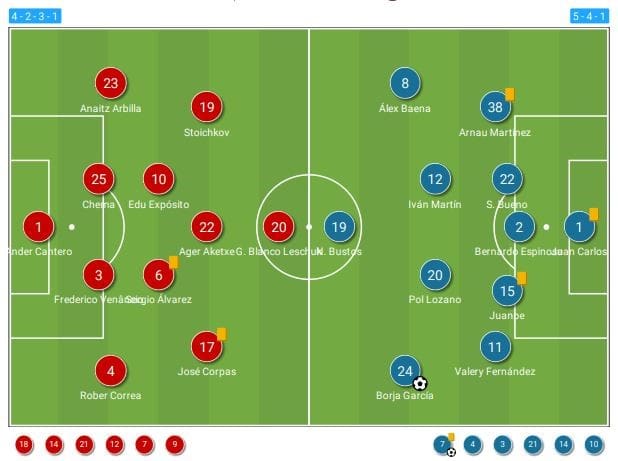
Both teams stuck to their formations from the first leg but chose to remain in the shape for the entire match this time around. They also both made changes in terms of personnel for the match with the two legs only three days apart from each other.
Eibar changed suspended right back Tejero with 35-year-old captain Arbilla, along with two more changes as the third top goal scorer in the league Stoichkov came in to replace Quique and Blanco taking the centre forward position from Fran Sol. This was a stronger squad for Eibar in the second leg compared to Eibar who looked to have a weakened starting eleven as big-name Stuani started on the bench along with González, Aleix García and Sáiz.
There were lots of substitutions during the match as the game entered extra time, but it was Stuani coming off the bench who sealed the victory for Girona in the end, making his absence from the starting 11 clear as an impact substitution.
Set pieces and quick starts
With Girona needing to score at least one goal with a win or a draw they would be desperate to get an early goal. From the kick-off, Girona showed their intent by getting the ball forward and putting it on the Eibar defensive line.
After just 43 seconds, Girona won a free-kick just inside the Eibar half. Eibar set up to defend with a row of seven players marking zonally and then three players in front to stop any short options from the set-piece.
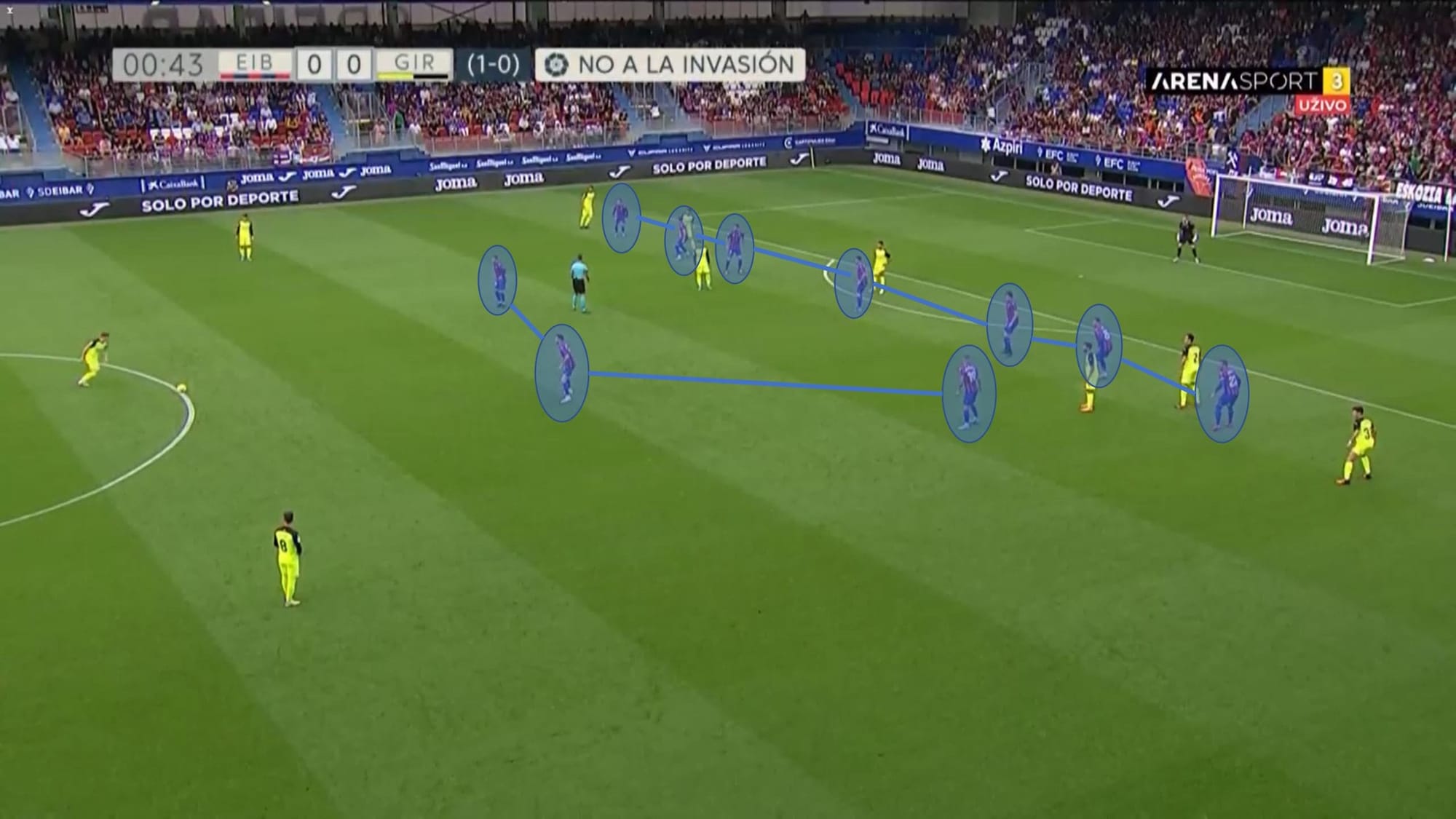
The free-kick was punted into the right half-space of the box and was first met by Eibar defender Chema. He didn’t get much power on the header causing the ball to fall in between the defensive line and the three attackers in the Eibar shape. Here, there was a pocket of space which was occupied by Borja Garcia, who hit a tremendous first-time volley into the top-left corner to put Girona 1-0 up inside merely 50 seconds.
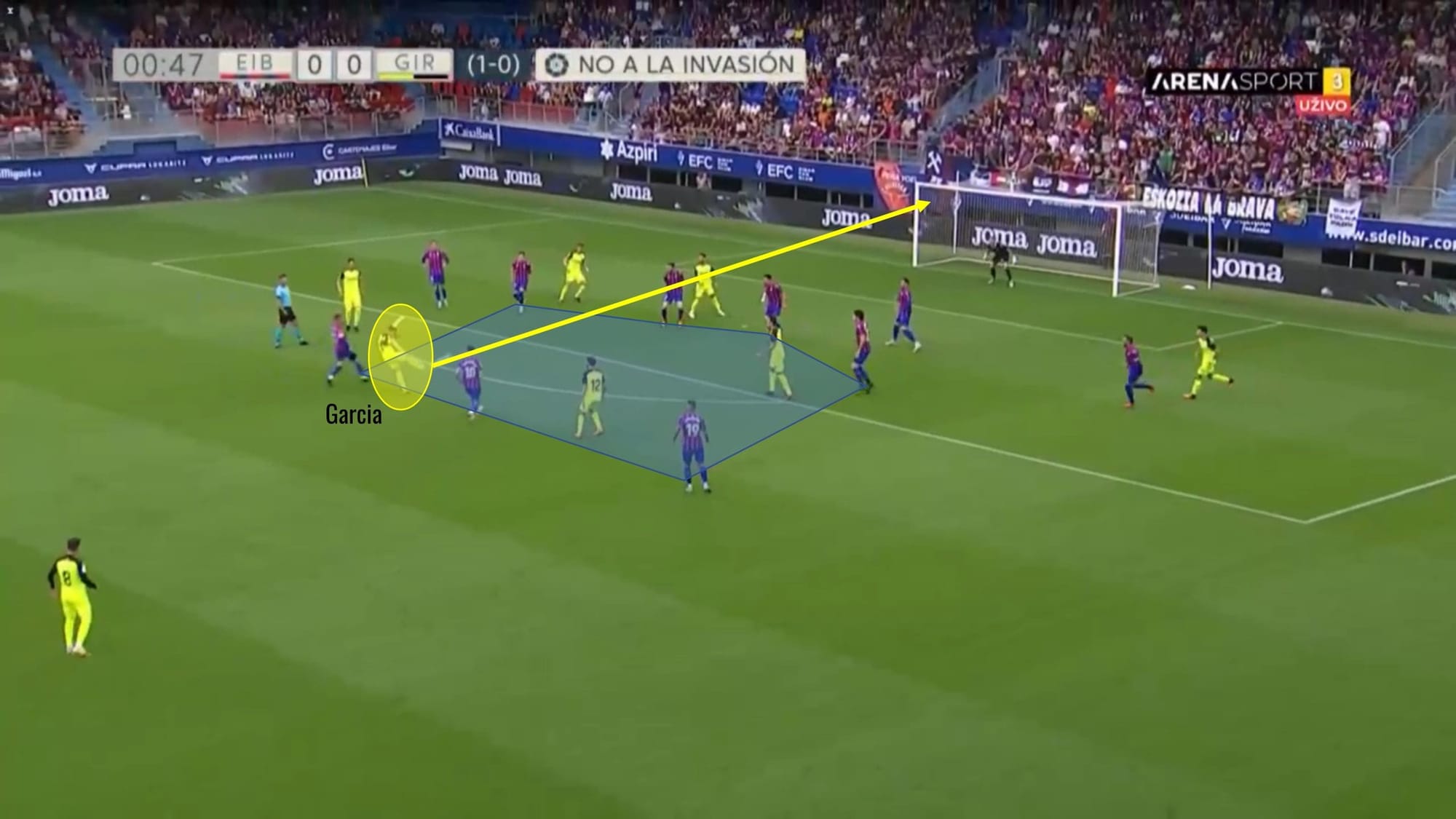
With this Girona had shown their intent, demonstrating that they were ready to get their first victory over Eibar since 2013. It was also a warning to Eibar that Girona will take any chance they are given with set pieces being an opportunity for the Catalonian side to get men forward.
Eibar looked to have a clear system for set pieces with two distinct banks of players to defend free kicks with zonal being the key feature of the marking. In their corners, it was the opposite, as they looked to go man-to-man with just two zonal men at the front post.
Girona carried the momentum of an early goal for the first 10 minutes, with the game being even between the two sides for the rest of the first half. Eibar certainly had the most chances with Girona only having the one shot compared to the seven for Eibar, however, none of them were on target.
Girona always came out best after each of the mid-half intervals having created another great opportunity within five minutes of the second half along with the first-half goal. However, it was not only in the regular 90 minutes that they started the better side, it was also in the first half of extra time.
Straight away, Girona put the ball on Eibar again from kick-off, aiming for Girona number 11 Fernández who had made the run into the box. Eibar made another mess of a clearance putting the ball out for an unnecessary corner, with the ball spinning off the shin of a defender.
Eibar had their setup in place with the man-marking and the two zonal men at the front post, against the Girona train which stood between the penalty spot and the far side of the six-yard box. A train of players for attacking a corner aims to leave the players at the back of the group free to win headers or remain unmarked in the box. With this in mind, the corner was floated towards a free run off the back of the group of Girona players with Stuani, also from the back of the group, drifting forward towards the goal.
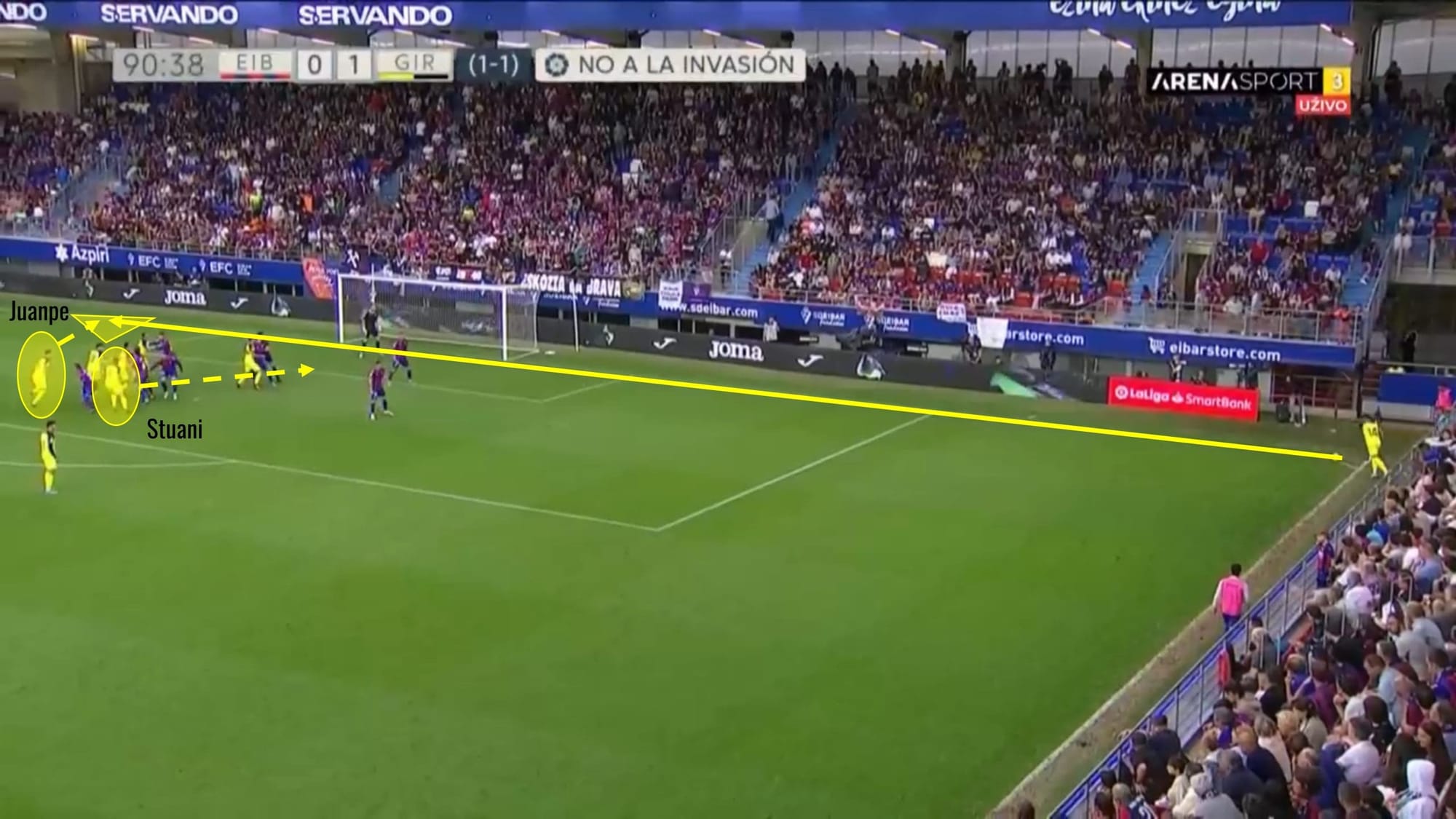
The first contact was from Girona centre back Juanpe who headed the ball towards Stuani free just in front of the keeper. As expected, leaving the league’s joint top goal scorer free in the box is not a great idea, especially in front of the goal with only the keeper to beat.
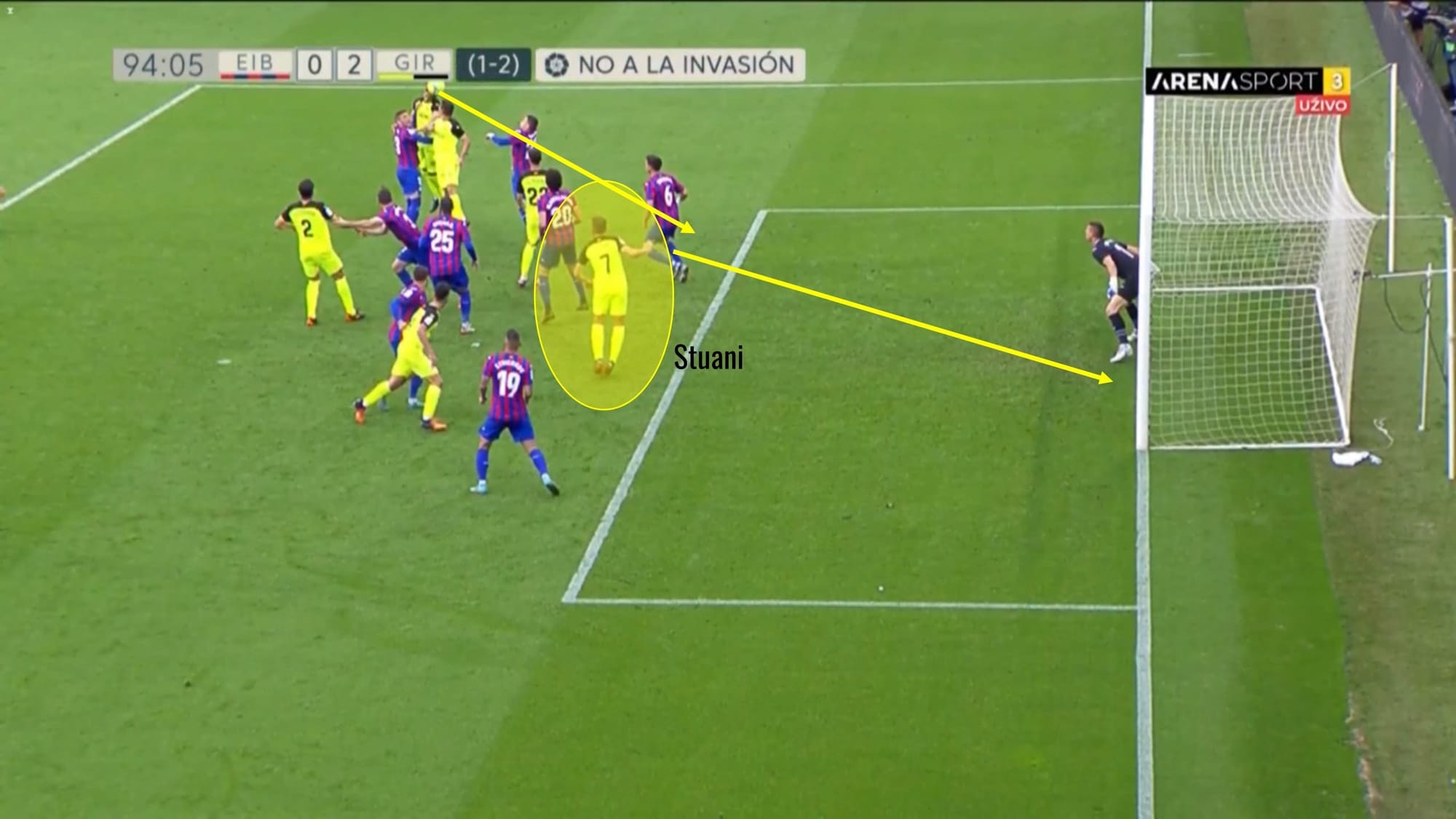
With the ex-Middlesbrough man Stuani only just onside, he directed the ball with perfect accuracy into the far side of the goal, leaving the goalkeeper with no chance of saving it. After a lengthy three-minute VAR check, the goal stood to give Girona the lead only 42 seconds into the first half of extra time.
The perfect game plan
With Girona taking the lead in the opening minutes, they made their task easier in that they only needed to score one more goal in the match and win this leg of the match. It is easier said than done but Girona were well prepared for the task and executed their game plan very well.
The Blanquivermells set up the same throughout the match even when they were winning on aggregate. Their shape remained the same as the lineup sheet with a 5-4-1, but it had a simple principle that meant it changed form depending on the opposition’s movement.
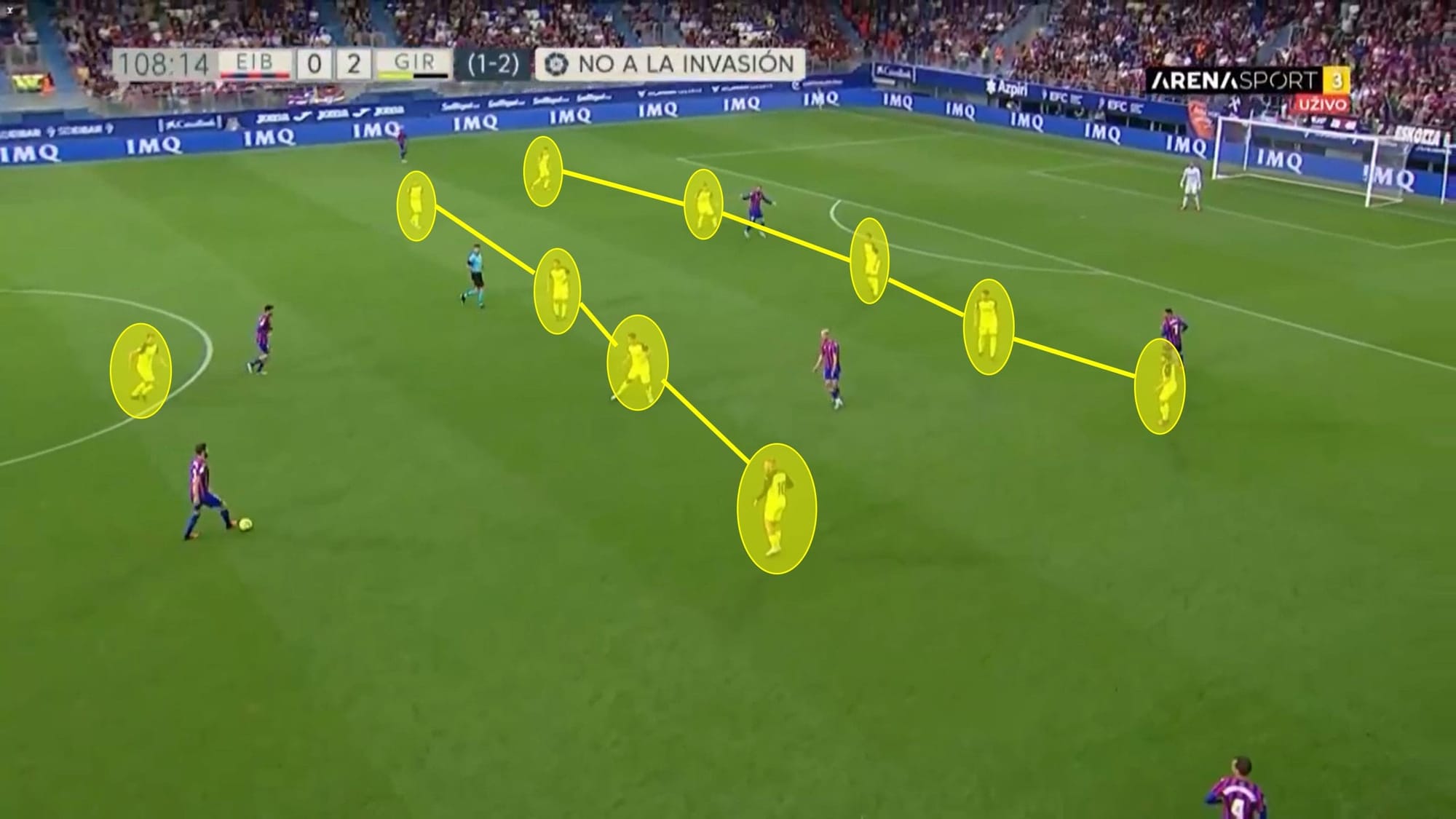
A fundamental part of Girona’s defensive success was the man-to-man marking employed in defence for the press and shape. This largely affected Baena and the former Real Madrid youth player Borja Garcia as the wide midfielders in the formation who were tasked with marking the full-backs of Eibar. This in turn meant Eibar struggled to go through the centre of the pitch with the high density of players, while it also meant that there was less space and time on the ball for the Eibar wide players with a 2v2 or 1v1 in these channels.
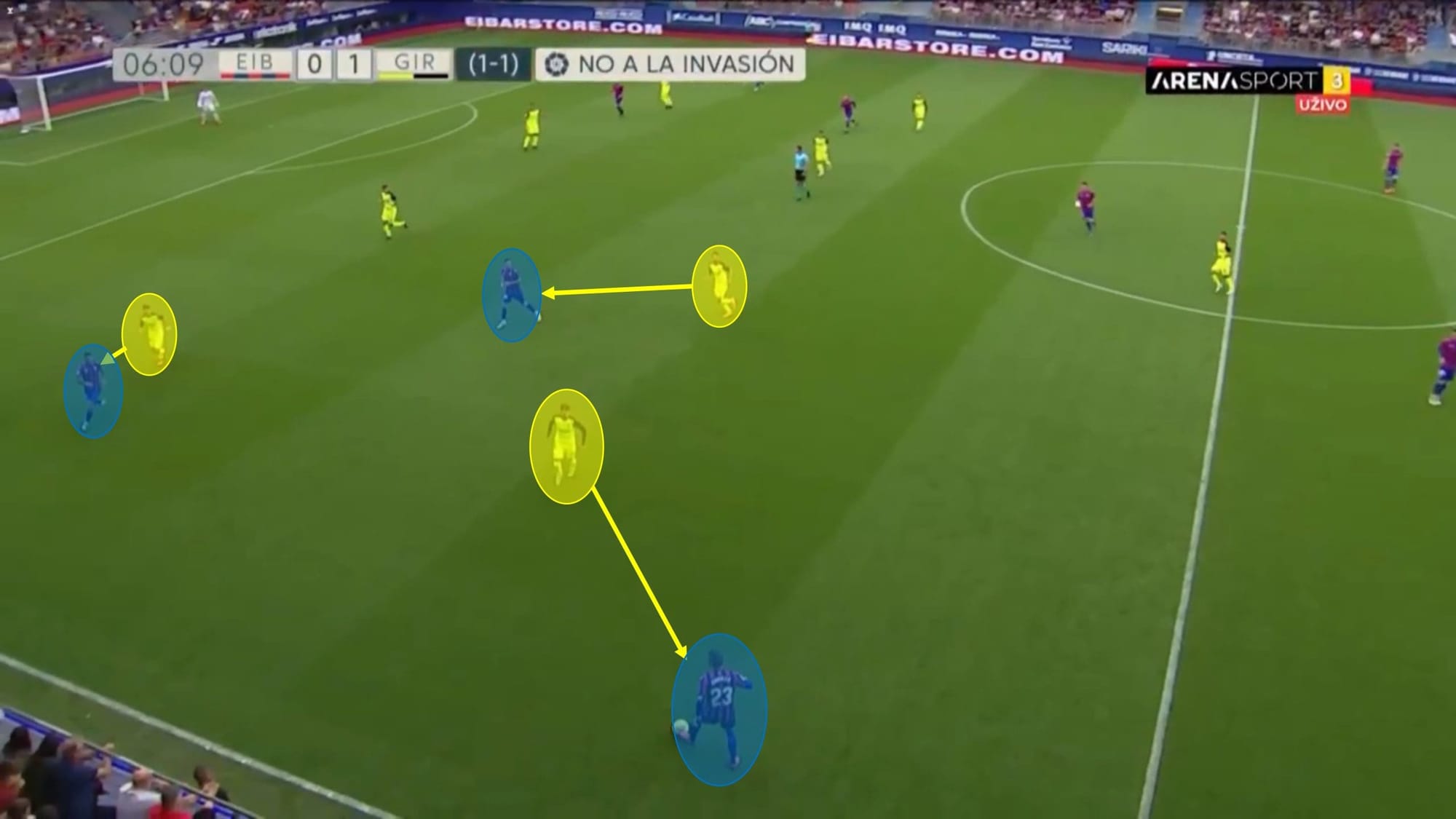
Girona also chose to give Eibar lots of time on the ball in defence and around the halfway line, only choosing to press when the ball reached the final third. Eibar did have lots of space in between the lines and could create passing options with simple rotations against this man to man marking, as this style is difficult to defend against midfielders that rotate frequently. Eibar did have 22 shots throughout the match with 69% possession, which highlights the amount of time they were given on the ball and their ability to break through the shape.
The biggest threat for Girona would be from a successful take-on as the man-to-man system is prone to giving the opposition lots of space for creative and skilful players to exploit qualitative differences. Eibar should have done more with the chances they had, as they would often dribble through the heart of the middle creating numerically superior attacks in their favour, but with no quality in the end.
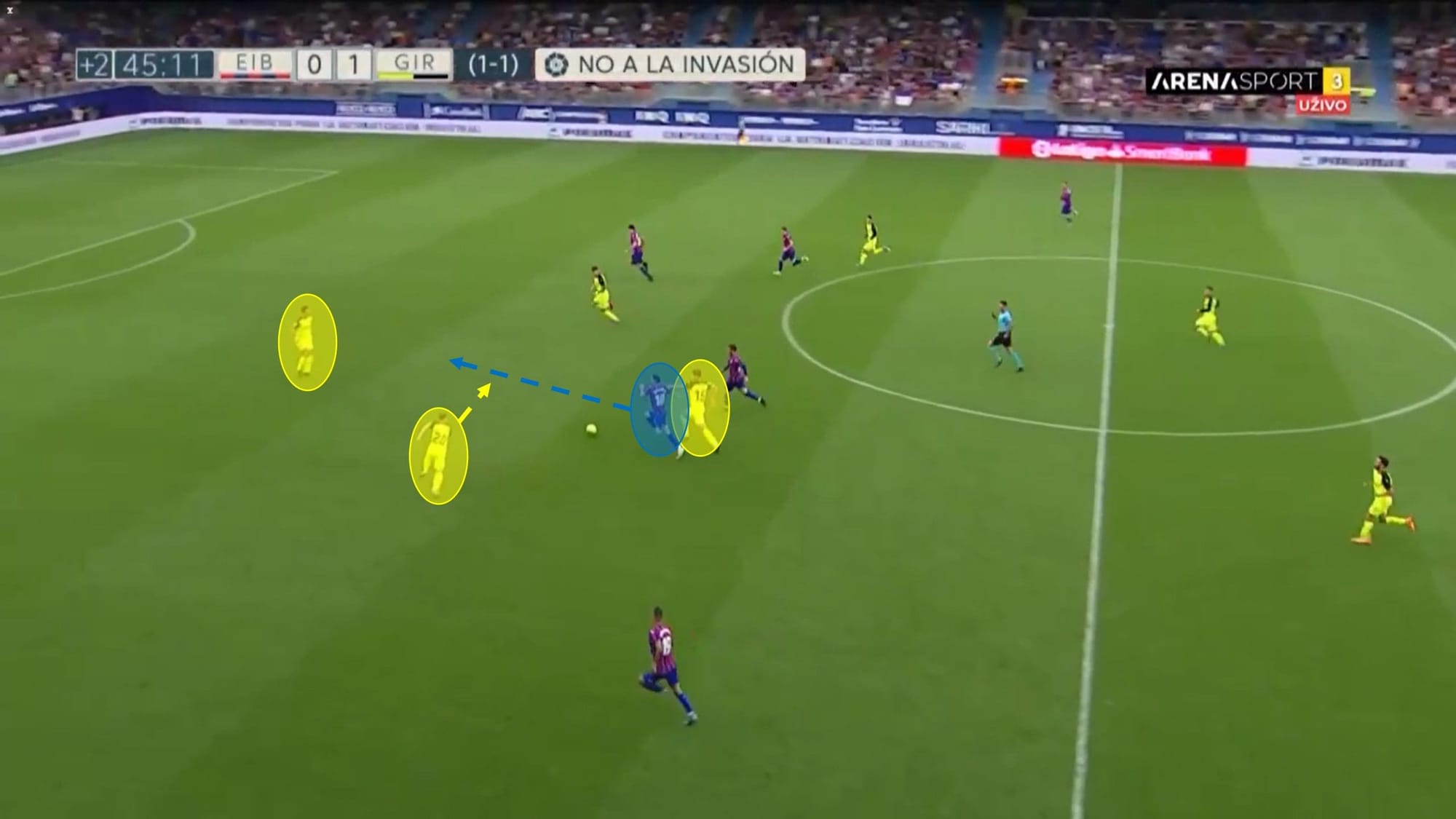
To combat the runs through the midfield, Girona looked to foul or halt the player on the ball by any means necessary, even if that meant picking up a yellow card. This is a risky tactic depending on the referee, who on this occasion was very lenient on most decisions and looking to keep the game going unless there were clear or serious infringements. This may be seen as unsportsmanlike, but it is something every team exploits at some point in the season.
On a handful of occasions, Girona chose to press Eibar using specific triggers to force a mistake or punt upfield. The trigger Girona used was on a slow backwards or horizontal pass, specifically when travelling towards the full-backs. This was made possible within the system as the wide midfielders were man-marking the full-backs, giving them the freedom to press high.
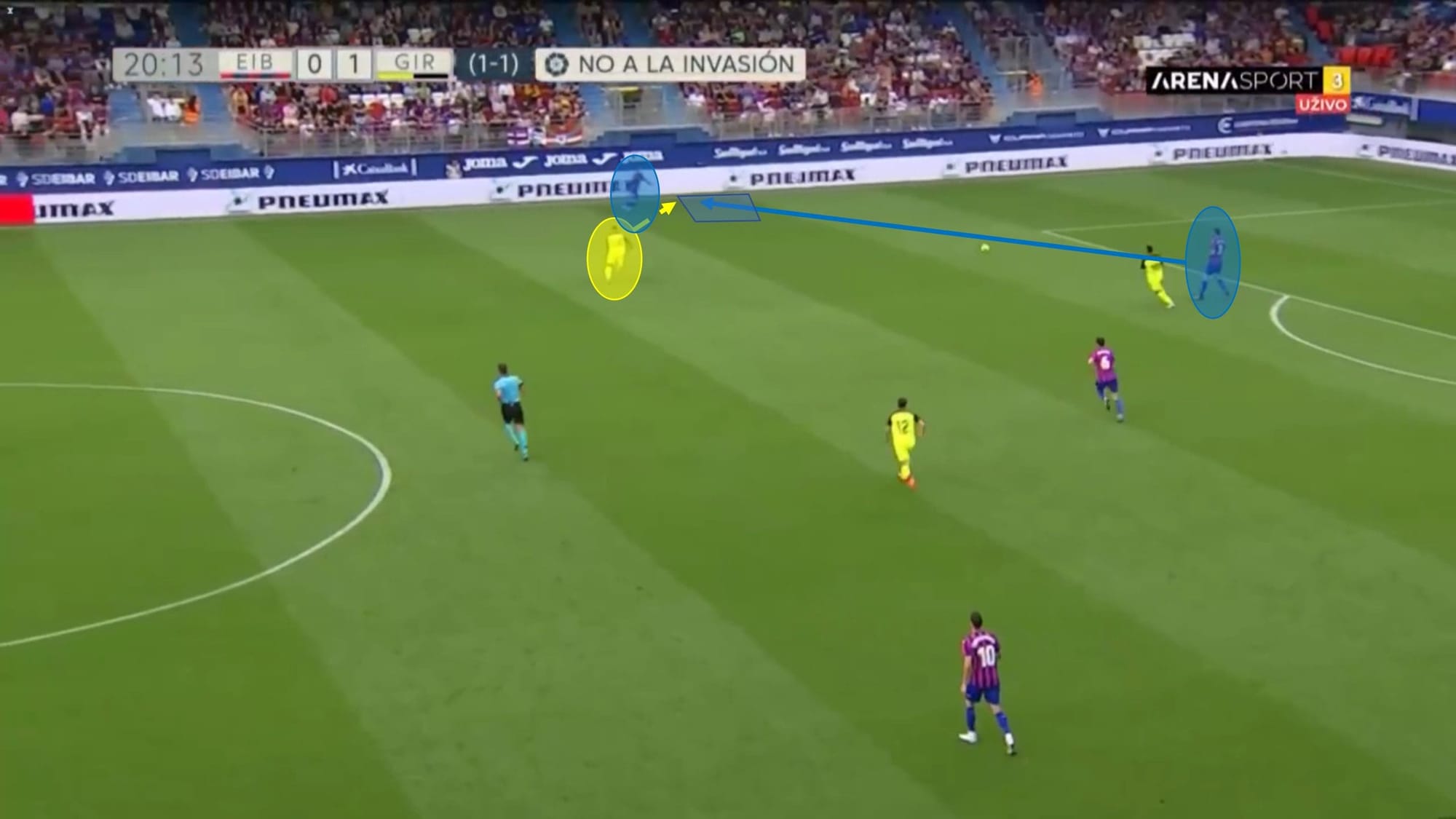
Even though Eibar had a 70% success rate on their long passes, they didn’t create many shots from the long balls as Girona were ready to challenge for the second balls. With everything working coherently at the back, Eibar were limited to long balls or the challenge of dribbling through the Girona shape to create chances. Leading them to cross the ball into the box 38 times in the match with a 50% accuracy while also choosing to take long shots, with an average shot distance of 20 metres per strike.
Just looking at the statistics alone, it would suggest that Eibar dominated the tie, but Girona didn’t concede any clear cut chances to the Basque side and limited them to just four shots on target to Girona’s three. This mostly came down to some brilliant tackles and countless blocks, even being saved by the crossbar on one occasion.
Safe play
Girona went to the Ipurua Municipal Stadium with the focus of staying solid and taking any chances that came their way. Achieving a clean sheet against the four highest scorers in the league was not only down to the defensive shape of Girona but also down to their smart decisions on the ball, especially when close to their own goal.
Girona always looked to play out from goal-kicks with the ball frequently being passed to one of the centre-backs from the goalkeeper. The perfect scenario for Girona is then to play out to the wide channel with a full back getting on the ball and for them to play down the line or look inside.
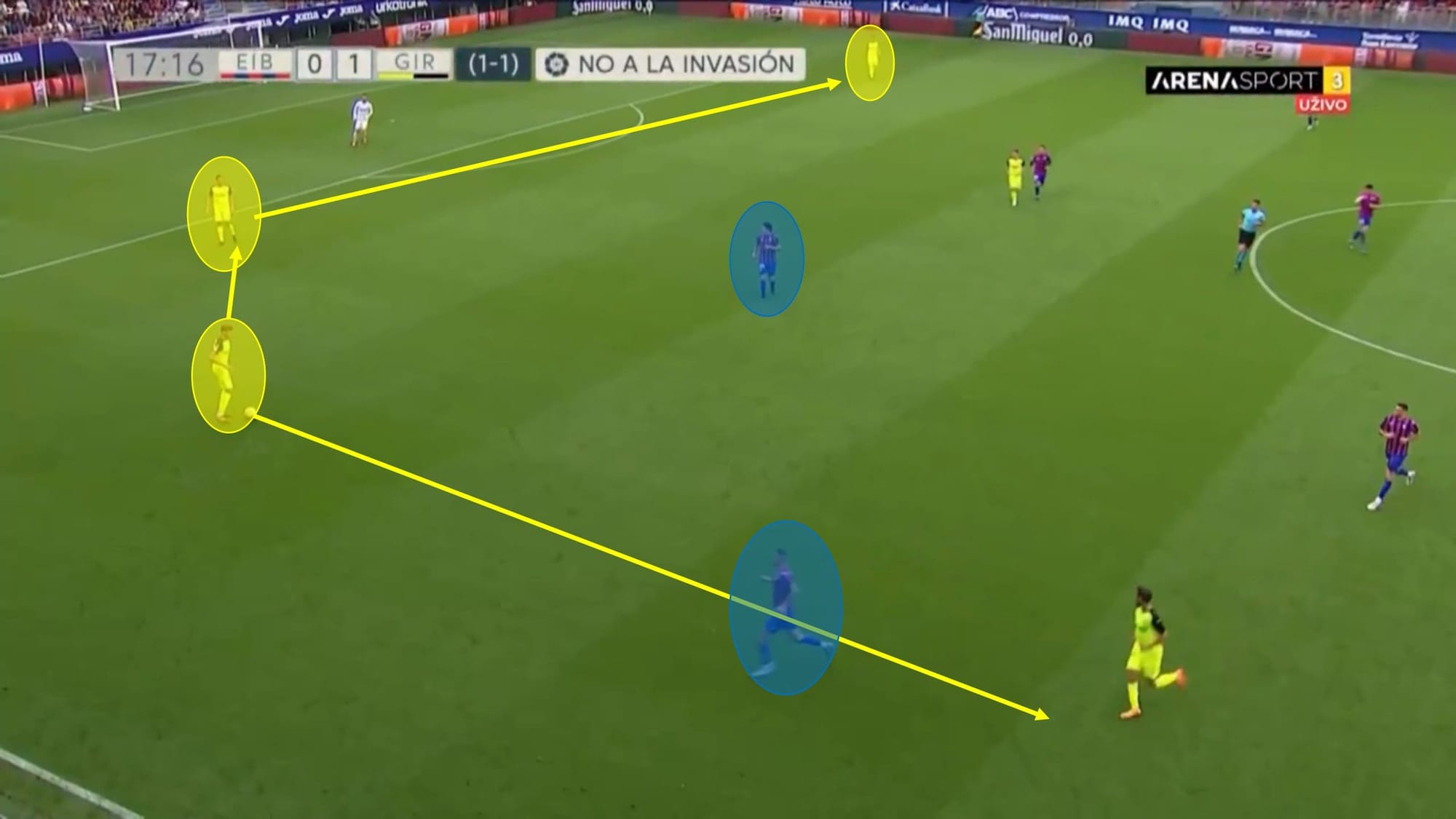
This is a low-risk option for playing out from the back because the ball is kept far away from the centre of the pitch while also providing some distance vertically up the pitch. If the full-back was to have no option, it would be circulated around the defence to the opposite full-back. With this in mind, Eibar pressed the full-backs cutting off the option down the line and any ball into the centre of the pitch.
If a Girona player had no options and was being pressed by the opposition, the ball would be kicked long upfield or to a wide player, as Girona focused on not losing the ball in dangerous areas of the pitch.
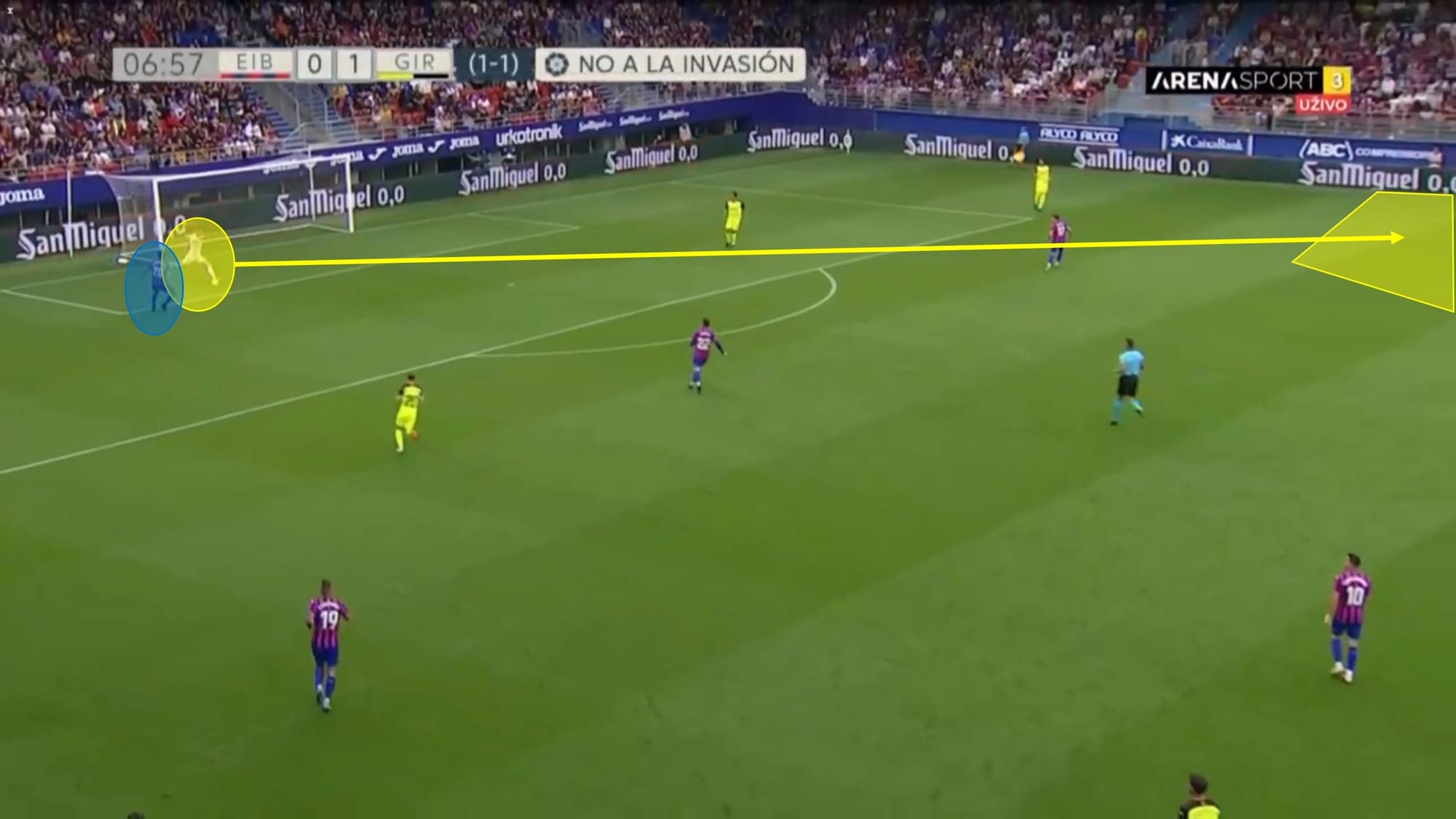
Girona lost the ball 140 times in the match, 23 times less than Eibar over the 120 minutes. 32% of those occurred in the third of the pitch closest to the Girona goal but didn’t result in any chances for Eibar, suggesting the decision to play in less dangerous areas of the pitch worked for them on this occasion.
Conclusion
The match could have easily gone either way, especially as Eibar will look back at the abundance of missed chances throughout the match, with the Stoichkov’s shot in the 87th minute coming centimetres from crossing the line after hitting the crossbar.
Girona will be delighted that their game plan was successful by keeping a clean sheet using the methods shown in the piece and limiting Eibar to just the four shots on target. The clinical finishing must continue if Girona are to implement this in the final of the playoffs against Las Palmas in the two-legged battle for promotion.






Comments